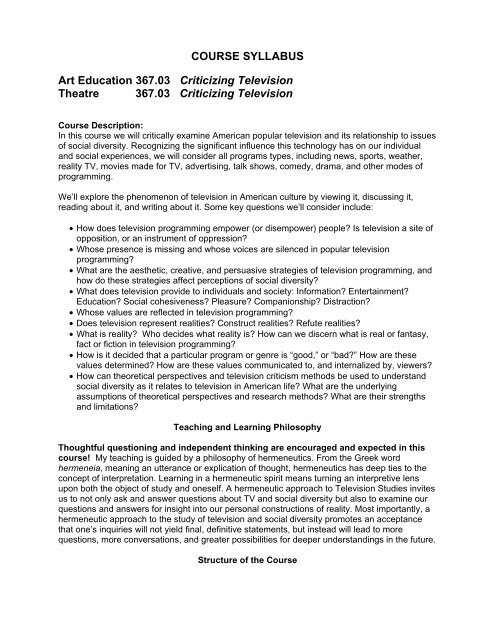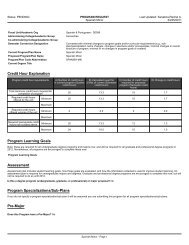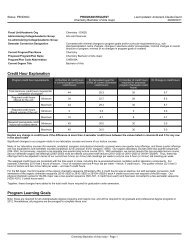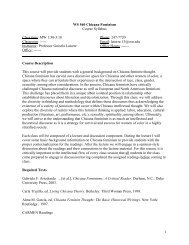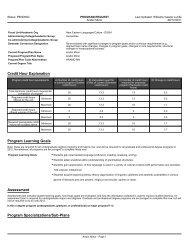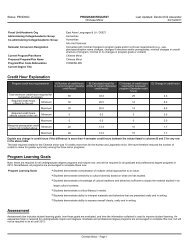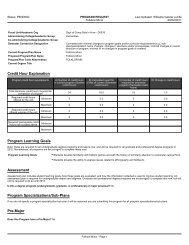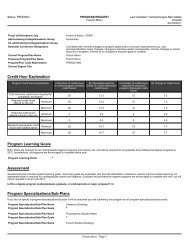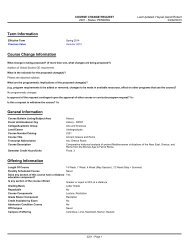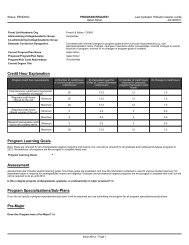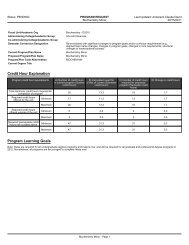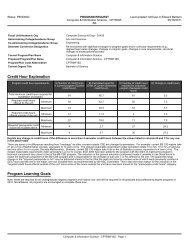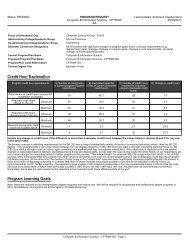COURSE SYLLABUS Art Education 367.03 Criticizing Television ...
COURSE SYLLABUS Art Education 367.03 Criticizing Television ...
COURSE SYLLABUS Art Education 367.03 Criticizing Television ...
You also want an ePaper? Increase the reach of your titles
YUMPU automatically turns print PDFs into web optimized ePapers that Google loves.
<strong>COURSE</strong> <strong>SYLLABUS</strong><strong>Art</strong> <strong>Education</strong> <strong>367.03</strong> <strong>Criticizing</strong> <strong>Television</strong>Theatre <strong>367.03</strong> <strong>Criticizing</strong> <strong>Television</strong>Course Description:In this course we will critically examine American popular television and its relationship to issuesof social diversity. Recognizing the significant influence this technology has on our individualand social experiences, we will consider all programs types, including news, sports, weather,reality TV, movies made for TV, advertising, talk shows, comedy, drama, and other modes ofprogramming.We’ll explore the phenomenon of television in American culture by viewing it, discussing it,reading about it, and writing about it. Some key questions we’ll consider include:• How does television programming empower (or disempower) people? Is television a site ofopposition, or an instrument of oppression?• Whose presence is missing and whose voices are silenced in popular televisionprogramming?• What are the aesthetic, creative, and persuasive strategies of television programming, andhow do these strategies affect perceptions of social diversity?• What does television provide to individuals and society: Information? Entertainment?<strong>Education</strong>? Social cohesiveness? Pleasure? Companionship? Distraction?• Whose values are reflected in television programming?• Does television represent realities? Construct realities? Refute realities?• What is reality? Who decides what reality is? How can we discern what is real or fantasy,fact or fiction in television programming?• How is it decided that a particular program or genre is “good,” or “bad?” How are thesevalues determined? How are these values communicated to, and internalized by, viewers?• How can theoretical perspectives and television criticism methods be used to understandsocial diversity as it relates to television in American life? What are the underlyingassumptions of theoretical perspectives and research methods? What are their strengthsand limitations?Teaching and Learning PhilosophyThoughtful questioning and independent thinking are encouraged and expected in thiscourse! My teaching is guided by a philosophy of hermeneutics. From the Greek wordhermeneia, meaning an utterance or explication of thought, hermeneutics has deep ties to theconcept of interpretation. Learning in a hermeneutic spirit means turning an interpretive lensupon both the object of study and oneself. A hermeneutic approach to <strong>Television</strong> Studies invitesus to not only ask and answer questions about TV and social diversity but also to examine ourquestions and answers for insight into our personal constructions of reality. Most importantly, ahermeneutic approach to the study of television and social diversity promotes an acceptancethat one’s inquiries will not yield final, definitive statements, but instead will lead to morequestions, more conversations, and greater possibilities for deeper understandings in the future.Structure of the Course
<strong>Art</strong> <strong>Education</strong> <strong>367.03</strong>; Theatre <strong>367.03</strong> Syllabus: <strong>Criticizing</strong> <strong>Television</strong> 2This course is organized around reading and writing about the phenomenon of television and itsrelationship to social diversity issues. There will be lectures drawn from concepts in theassigned readings, however the emphasis in this course is on engaging with ideas throughdiscussion and writing.Discussions about the readings and in-class program viewings are a vital part of your learningexperience. You’ll have the opportunity to wrestle with ideas, theories, and viewpoints intelevision criticism, and you’ll develop an awareness of how these ideas are relevant to oursocial worlds and everyday life. Your goal this quarter is to think critically, creatively, and mostof all, think for yourself and question the world you are in. I urge students to ask questions,make comments, and offer informed, thoughtful opinions. We will learn a lot from one anotherthis quarter!Writing instruction will occur throughout the quarter, and will be geared toward building uponand advancing your skills in producing writing characterized by:• a clear sense of purpose• effectively ordered and fully supported ideas• style appropriate to purpose and audience• control of grammatical and mechanical elementsWriting instruction will take place through class lectures, class discussion, in-class writingactivities, instructor-written feedback on papers, informal peer writing review activities, aresearch and writing project that entails a proposal, drafts, formal peer review and paperrevision, and individual writing consultations.In-Class Activities• We will reflectively discuss readings, beginning with topics you bring up inyour Personal Responses to reading assignments.• We will watch and critique, positively and negatively, excerpts fromtelevision programs by applying different critical methodologies.• We will engage in brief, informal in-class writing exercises to demonstratecomprehension of readings and to facilitate discussions.AssignmentsReadings:There is a significant amount of reading in this course. The materials are drawn from bothacademic and popular writings about television; the readings are carefully chosen to introduceyou to general concepts in <strong>Television</strong> Studies and to help you grapple with key theoreticalperspectives in television criticism. The readings will provide a strong foundation for your essayand oral presentation assignments. I realize that the concepts and theories may be unfamiliar;some of the material may seem challenging, but do your best to complete each reading so youare prepared to contribute to the class discussion and/or express the ideas during the in-classwriting activities.Reading responses:Brief written responses to the assigned readings will be required where indicated on the coursecalendar. The phrase “Read and respond in writing” precedes all reading assignments thathave a required response.
<strong>Art</strong> <strong>Education</strong> <strong>367.03</strong>; Theatre <strong>367.03</strong> Syllabus: <strong>Criticizing</strong> <strong>Television</strong> 3Unless you are given a specific writing prompt to follow for a particular reading, please use theformat below, including both sections in your response:1) Objective Summary. In about 50-100 words (minimum), summarize whatyou think to be the most important points of the reading. Do not comment onthem, but report them accurately.2) Personal Response. Pick one sentence or idea from the reading that isparticularly important to you, for whatever reason. Quote the sentence orexplain the idea, and write about what this sentence means to you and why itis significant to your life.Each reading response will be graded using a system of check+ (5 pts.), check (3 pts.), check-(1 pt.). Reading responses will be evaluated on depth of engagement with the material,demonstration of your understanding of the topic and concepts, quality of connections you makewith the material, and/or questions you raise about the reading.Essays:You will write 2 critical analysis papers, one mid-term project (paper & presentation), onepostmodern television paper, and one final research paper. To widen your exposure to a varietyof ideas and experiences, you should not write your midterm essay or final essay aboutprograms or commercials that we have previously given substantial discussion in the class. Ifyou have any questions about this, please see me.All essays must be word-processed, double-spaced, and printed on only one side of the paper.All essays must follow either APA or MLA citation format. The OSU Libraries website offershelpful guidance for formatting citations in a variety of different styles. Visithttp://library.osu.edu/sites/guides/index.php#apaguide and follow the links.Writing Process and Development: Grading, Feedback, and RevisionAll written assignments will be graded by1) the quality of the writing, and2) the content of the writing.Grading and Feedback:Writing feedback is intended to establish a dialogue between student and teacher, with the goalof supporting and furthering the student’s development of writing skills and personal writingvoice. Each essay (and presentation) assignment will be returned to students with a detailedgrading rubric sheet that identifies strengths, areas where improvements may be needed, andsuggestions for extending thinking on their topic.Revision:One of the Critical Analysis papers may be revised and resubmitted. The revised essay will beevaluated on changes made in response to feedback; the grade on the revised paper will standas the final grade for the paper.Writing as Process:The last essay assignment of the quarter, the Final Paper, also serves as the final exam and issubmitted during exam week. This assignment will give students the opportunity to develop their
<strong>Art</strong> <strong>Education</strong> <strong>367.03</strong>; Theatre <strong>367.03</strong> Syllabus: <strong>Criticizing</strong> <strong>Television</strong> 4writing through a structured process. Students will choose a topic that links personal televisionexperience with perspectives in <strong>Television</strong> Criticism, and will craft their writing through proposal,research, preliminary draft, peer review, and final draft stages. Students will receive feedbackon their developing essay on three separate occasions before submitting their Final Paper:1. Instructor’s written feedback on proposal2. A personal writing consultation with Instructor3. Written and oral peer feedback in a student Peer Editing WorkshopRequired TextsJonathan Bignell, An Introduction to <strong>Television</strong> Studies, London: Routledge, 2004.Andrea Lunsford, The Everyday Writer, 3rd ed. New York: Bedford/St. Martin's, 2005.Other required readings are available in PDF or Word format on the <strong>Criticizing</strong> <strong>Television</strong>website (Carmen) and you are responsible for having a means for accessing and printing them.On occasion, I will distribute readings and instructional handouts in class or by emailattachment.Additional RequirementsEquipment access: Students are expected to have access to a television and VCR or DVDplayer for the completion of assignments.Carmen website: Required readings for the class are available at the Carmen website. In orderto have access to our class’s Carmen materials, you must activate your OSU email account andobtain your username and password. The course website can be accessed athttps://carmen.osu.edu/. You will submit some of your papers via Carmen, and I willoccasionally post handouts and related course materials at the Carmen website.Email: A reliable email account (that you check on a regular basis) is a necessity.Attendance, Preparation, and ParticipationCourse PoliciesAttendance:Attendance is vital to the success of this class and to your development as a writer. Attendanceis taken each day and an unexcused absence will count as a zero for class participation on thatday. Excused absences, such those for documented illness, family tragedy, religiousobservance, or travel for inter-collegiate athletics, will not affect your grade--however allexcused absences require written documentation. You are expected to be present and punctualand you are expected to stay through the duration of each class. Arriving late or leaving earlymay be considered an unexcused absence unless arrangements have been made for it to becounted as an excused absence.About Preparation and Participation:• Active participation on a daily basis is crucial for your success in this class, as well asthe overall success of the class. I may, on occasion, collect and grade an in-class writingresponse to a reading assignment; this will be factored into the reading response andparticipation grade for the day.
<strong>Art</strong> <strong>Education</strong> <strong>367.03</strong>; Theatre <strong>367.03</strong> Syllabus: <strong>Criticizing</strong> <strong>Television</strong> 5• Participation means paying attention while instructor and classmates are speaking andresponding appropriately.• Participation means offering thoughtful comments and asking questions when aclassmate gives an oral presentation.• Participation means giving your full critical attention to the in-class television viewingsand responding with questions or comments when the program is finished.• Participation is graded on a daily basis. Active engagement in the course materials andquality of comments will assure you of receiving full participation credit for that class.Failing to pay attention, exhibiting distracted or distracting behavior in class, orconsistently not contributing to discussions will negatively impact your participationgrade.• If there is a reason why you cannot fully participate in class discussions please see meas soon as possible so that we can discuss your options.• And, last but not least, this class is based on discussion. Lack of student preparation andparticipation means dull, uninspiring discussions--which will make for a long, boringquarter for everyone! Come prepared to participate by having carefully read theassigned materials, and try to make a comment or two at every class meeting!AssessmentYour grade in <strong>Criticizing</strong> <strong>Television</strong> is based on the number of points achieved out of 400possible points. The final letter grade will be determined by dividing the final accumulated pointtotal by 100 and then using the Grade Scale. For example, if a student’s final accumulatedpoints are 356, the final quarter grade will be 3.56 or A-.<strong>Criticizing</strong> <strong>Television</strong> Point ScaleAttendance, Preparation, and Participation 50Reading Responses 35Critical Analysis Paper # 1 25Critical Analysis Paper # 2 25Postmodernism Paper 25Mid-term Paper/Presentation 100Proposal for Final paper 20Draft (for peer editing session) 20Final Paper 100Total possible points 400Grade ScaleA 3.85-4.00A- 3.50-3.84B+ 3.15-3.49B 2.85-3.14B- 2.50-2.84C+ 2.15-2.49C 1.85-2.14C- 1.50-1.84D+ 1.15-1.49D 1.00-1.14
<strong>Art</strong> <strong>Education</strong> <strong>367.03</strong>; Theatre <strong>367.03</strong> Syllabus: <strong>Criticizing</strong> <strong>Television</strong> 6E 0.00-0.99Late Submissions:Assignments must be completed and submitted on time. Assignments should be turned induring the class period when they are due. A late assignment will result in a deduction of onefull letter grade for each day past the due date (for example, B+ to C+). The grade will not beaffected if an assignment is late for reasons that would result in an excused absence and writtendocumentation is required. If you know that you cannot attend class when an assignment is due,please contact me as soon as possible in advance of class to arrange for submission of yourassignment.Incompletes:Incompletes for the course will not be given without serious cause, to be determined by theinstructor and the student.Academic HonestyAcademic honesty is fundamental to the activities and principles of a university. All members ofthe academic community must be confident that each person’s work has been responsibly andhonestly acquired, developed, and presented. Any effort to gain an advantage not given to allstudents is dishonest, whether or not the effort is successful. The academic community regardsall academic dishonesty as an extremely serious matter, with serious consequences that rangefrom probation to expulsion, as well as loss of credit for an assignment or a course. The mostcommon form of misconduct is plagiarism. Remember that any time you use the ideas or thestatements of someone else, you must acknowledge that source in a citation. This includesmaterial you have found on the Web. The University provides guidelines for research on theWeb at http://library.osu.edu/sites/guides/index.php If in doubt about plagiarizing, paraphrasing,quoting, or collaboration, consult the instructor for guidance. Any suspected cases of academicmisconduct will be reported to the Committee on Academic Misconduct. For additionalinformation, see the Code of Student Conduct (http://studentaffairs.osu.edu/resource_csc.asp).ResourcesThe OSU Writing Center is a free service that provides professional consultation and/or tutoringto students and faculty at any stage of the writing process. They provide excellent service. Youmay set up an appointment by calling 688-4291 or you can meet with a writing consultant ateither 475 Mendenhall Laboratory or at the Younkin Success Center. The OSU Writing Centerwebsite is http://cstw.osu.edu/writingCenter/Students With Special NeedsStudents with disabilities that have been certified by the Office forDisability Services will be appropriately accommodated, andshould inform the instructor as soon as possible of their needs. Iwill rely on the Office for Disability Services for assistance inverifying the need for accommodations and developingaccommodation strategies. If you have not previously contacted
<strong>Art</strong> <strong>Education</strong> <strong>367.03</strong>; Theatre <strong>367.03</strong> Syllabus: <strong>Criticizing</strong> <strong>Television</strong> 7the Office for Disability Services, I encourage you to do so. TheOffice for Disability Services is located in 150 Pomerene Hall,1760 Neil Avenue; telephone 292-3307, TDD 292-0901;http://www.ods.ohio-state.edu/(2) Critical analysis papers:Essay AssignmentsThere are two critical analysis papers. These papers are intended to give you experience inreading and responding to academic television criticism. For each critical analysis paper, youwill write a brief, critical, and well-developed argument on an assigned article.Your analysis should consist of a brief summary of the article, and then a thoughtfulcommentary on one or two issues either raised by the article or related ideas you thought ofwhile reading the article. Your essay should demonstrate a strong grasp of the authors’argument(s) and the issues that support or illustrate the claims being made. Show bothappreciation and criticism in your analysis by explaining what was effective or ineffective in theauthor’s arguments, and point out specific examples in the article that support your assertions.A successful Critical Analysis Paper will have well reasoned connections with course conceptsas well as clear evidence of your own critical thinking. This means you will need to reachbeyond simply summarizing the article and author’s statements to explain how the text connectswith your experience of television and your understanding of perspectives and issues intelevision criticism. Each essay should be a minimum of 4 pages. (Each critical analysispaper: 25)Purpose of Critical Analysis papers:• To practice and improve writing and reading skills.• To develop critical thinking skills.• To understand the development and function of a thesis statement or idea.• To understand how thesis ideas are supported through argumentation and evidence.• To identify and enter into conversation with an author’s key issue(s).Midterm Paper & Presentation: Whose reality? What reality? Theorizing Reality inAmerican <strong>Television</strong>Midterm Paper: For your midterm paper/presentation project, you will tape an episode of a“reality” TV show and analyze it using perspectives covered thus far in class (semiotics,narrative themes, genre) to create an argument for how this program does or does not constructsocial or individual realities in American life. You are not limited to shows that are alreadyassociated with the reality genre, therefore, you may choose a program that you believe wouldnot typically be labeled as a reality TV show, but you are able to present a case for it being aprogram that constructs realities. This will open up many opportunities for you to think creativelyand outside of the genre boundaries that often classify programming.Some questions you might consider include:
<strong>Art</strong> <strong>Education</strong> <strong>367.03</strong>; Theatre <strong>367.03</strong> Syllabus: <strong>Criticizing</strong> <strong>Television</strong> 8• What narrative(s) are being used to convey a sense of reality in American life? Whoseexperiences are privileged and whose are excluded?• What “hidden” assumptions help these narratives to function? Who benefits from this“reality”--or who is harmed by this “reality?”• Are there binary oppositions at work in this construction of reality? If so, how might youproblematize or challenge realties built on binary oppositions?• Who is the intended audience(s) for this program? Why was this program (and particularview of reality) created? In other words, what purpose does it serve for Americanindividuals and society?• What production strategies (lighting, camera angles, sound, etc.) or textual strategies(visual, verbal, acoustic codes, or signs, connotations, genre recognition) are used tocommunicate to audiences and/or create a persuasive reality?• How does this program work to reinforce (or resist) dominant social realities of class,race, ethnicity, gender, sexuality, age, religion, and/or (dis)ability?A successful paper/presentation will synthesize specific and focused examples from theprogram, concepts from our TV criticism readings and articles, and personal reflections topresent a persuasive case for how American realities are constructed in/by the program.Minimum 5 pages, not including reference and title pages.Midterm Presentation: In your presentation to the class, you’ll share an excerpt (approx. 3-5minutes) of the program you wrote about. This excerpt should illustrate or support yourargument for how the program does or does not construct social or individual realities. Be sureto point out how this program clip, or issues surrounding the concept of the program, relate to 1or 2 course concepts covered thus far. Bring a few questions or statements to facilitate a brief,informal discussion about your program clip/topic. Presentations should be 10-15 minutes inlength. (Paper 50 & Presentation 50 for 100 possible points)Both written and oral presentation components are required for the Midterm project. Omission ofeither component will result in a failing grade for the entire Midterm project.Purpose of Midterm Paper/Presentation:• To develop your ability to examine a form of television programming and determine howit fits within the overall scheme of <strong>Television</strong> Criticism.• To develop and extend your understanding of genre and how a program’s conventions,production choices, aesthetic qualities, create realities for individuals or cultures.• To develop your research and critical thinking skills.• To develop your oral presentation skills and verbal ability to describe and articulate theimportance of a topic.• To give you a start on your final paper if you choose to continue pursuing this topic.Postmodern <strong>Television</strong> PaperWatch an episode of a TV show currently on the air that you believe is an example ofpostmodern television. How does this postmodern program connect with an audience? Inwriting your paper, you will want to draw upon terms and ideas in Bignell Ch. 7, the Simpsonsarticle, and lectures. Some ideas to consider are reflexivity, intertextuality, fragmentation in theconstruction of subjectivity/identity.Postmodernism is sometimes associated with blurring of boundaries and subversion of beliefsystems… Do you detect a blurring of boundaries in the program—if so, what boundaries are
<strong>Art</strong> <strong>Education</strong> <strong>367.03</strong>; Theatre <strong>367.03</strong> Syllabus: <strong>Criticizing</strong> <strong>Television</strong> 9being disrupted and what are the effects on a viewer? Do you find evidence of a mixture orconfusion of popular culture and elite culture? How are traditional notions of time and historychallenged?Who is the intended audience? What signs, codes, or connotations reinforce this audience orsubject position? What assumptions are made about the audience? Think about visual, verbal,acoustic codes. What codes or signs support the representations and contribute to itspostmodern qualities? How did this program fit into the programming “flow” at the time it wasaired? Provide at least 3 specific examples from the program to support your argument aboutwhy or why not the program is an example of postmodern television and how it positions anaudience. You are expected to synthesize readings, lectures, and discussions. 4 pageminimum. (Postmodernism Paper 25)Purpose of Postmodern Paper:• To develop and strengthen your understanding of how gender, ethnicity, race, or classcan be theorized through postmodernist and modernist perspectives on history andsociety.• To expand your understanding of “texts,” “readings,” and how these terms apply topostmodern television experiences in society.• To develop your understanding of subjectivity, particularly how subjectivity relates toone’s perception of self and others in the production and viewing of television.• To develop and extend your critical thinking skills through the application of a keytheoretical lens in <strong>Television</strong> Studies.Final Paper: Connecting the Personal and the Social through the Study of TV*Paper Topic Proposal – 20*Final Draft for Peer Edit Session - 20*Finished Paper, Draft, and Peer Edit notes –100The final assignment for this course is to write a formal critical essay. This paper will be acapstone experience of personal and theoretical insights of this quarter because you will:analyze your own way of watching television through the theoretical lenses and methodsexperienced this quarter.Your essay should address the ways in which your American identity is constructed from morethan your individual experience and understanding. You will discuss how your personal identityhas been shaped through the phenomenon of television and explain how your identity mirrors alarger trend or is influenced by ideologies in respect to social diversity.You will use examples to illustrate your claims about identity and social diversity ideologies. Youmay write about your experience with television in general, or discuss a particular program orTV event that has made a significant impression upon you in respect to social diversity issues.You may choose to build upon and extend your midterm project topic for this Final Paper.A distinguishing feature of the Final paper is the expectation that you will employ a televisionstudy method for the purpose of collecting data to support an argument or claim, or to answer aquestion. You may choose from semiotics, narrative analysis, or content analysis; you maydecide to work with one method, or you may find it necessary to combine two methods.
<strong>Art</strong> <strong>Education</strong> <strong>367.03</strong>; Theatre <strong>367.03</strong> Syllabus: <strong>Criticizing</strong> <strong>Television</strong> 10To help you focus and develop your ideas and distribute the work for this paper, you will submita paper topic proposal and annotated bibliography several weeks before the paper is due. Youwill receive written feedback on your proposal and you will have the opportunity to meet with theInstructor to discuss your paper’s development and revise your proposal and/or preliminarydraft. Later, there will be a required peer editing session where students exchange helpful,constructive written and oral feedback on their drafts. The final paper should be at least 5pages, not including reference and title pages.Purpose of Final Paper:• To create a capstone experience that draws upon and deepens your understanding oftelevision criticism concepts and perspectives encountered throughout the quarter.• To combine personal reflexivity with the analysis and research of a televisionphenomenon, with the purpose of understanding and articulating the social andcontextual effects of TV in one’s personal and social worlds.• To engage in the progressive development of research and writing, including thedevelopment of a topic proposal, annotated bibliography, and essay draft(s).CRITICIZING TELEVISION CALENDARWEEK 1Tuesday (first class)The Personal is Political: Introduction to TV and Social Diversity IssuesSocial Diversity Focus: Race; Ethnicity; Gender; Class; LGBT (general introduction to issuesof social diversity and their relationship to television programming and viewing in the UnitedStates)Class Activities:Introductions; go over syllabus, course requirements, etc.In-class Writing & Discussion: Informal writing: your observations of diversity on TV, shareand discuss in classIn-class Viewing & Discussion: The Cosby Show (What is social diversity? How does<strong>Television</strong> affect perceptions of social diversity? (Discuss television critics’ divided views on TheCosby Show and diversity in America)ThursdayTV Criticism Methodology and the Study of Social Diversity IssuesSocial Diversity Focus: Class; Social construction of technology and “progress”Due Today:Read: Vande Berg, Gronbeck, & Wenner (pp. 3-10) & Vande Berg, Gronbeck, & Wenner (pp.19-31)Read: Williams, R. (1974/2003). <strong>Television</strong>: Technology and cultural form (pp. 1-25)Assignment: Write a personal profile, post your profile/photo on the CARMEN website bymidnight Monday, 4/3Today’s readings focus on the following topics:• Purpose of television criticism?
<strong>Art</strong> <strong>Education</strong> <strong>367.03</strong>; Theatre <strong>367.03</strong> Syllabus: <strong>Criticizing</strong> <strong>Television</strong> 11• Forms of TV criticism; Qualities of academic television criticism;essential components of a TV criticism essay• Why study television?• History of television’s development• Technological determinism; social history and uses of TVClass Activities:In-class Writing & Discussion: Informal written responses to questions: Why Study<strong>Television</strong>? What is TV Criticism? What role does TV play in perceptions of Social Diversity?In-class Writing Instruction: Strategies of <strong>Television</strong> Criticism; Characteristics of Popular andAcademic criticism; Considering your audienceWEEK 2TuesdayEconomic and Socio-Historical Contexts of American TV Viewing:The blurring of public and private spacesSocial Diversity Focus: Class; Race; GenderDue Today:Read: Bignell, Ch. 1 Studying <strong>Television</strong> (pp. 13-27)Read and respond in writing: L. Spigel (2001), The Suburban Home Companion. pp. 31-59.Today’s readings focus on the following topics:• Post-war changes in the social structure of suburban middle class• How has TV both united and divided America?• Blurring of public and private space; TV and the organization of social space,political space, public and private spaces• TV’s influence gender roles and assumptions about gender characteristics• Historical contexts and characteristics of TV viewing• <strong>Television</strong>’s influence on the development of an imaginary social lifeClass Activities:In-class Viewing & Discussion: Brady Bunch, Sons & DaughtersIn-class Writing Instruction: How to write a summary or abstract of an article or chapterThursdaySemiotics and Audiences: Reading the Signs of Gender & ClassSocial Diversity Focus: Gender; ClassDue Today:Read: Bignell, Ch. 4 <strong>Television</strong> Texts & NarrativesRead: Budd, Craig, and Steinman (1999). The Cascade Commercial---on narrative, style, andideologyToday’s readings focus on the following topics:• Semiotics and the study of television• Narratives and the construction of expectations about, and perceptions of,gender roles and class structures• Narratives and their function in TV commercials
<strong>Art</strong> <strong>Education</strong> <strong>367.03</strong>; Theatre <strong>367.03</strong> Syllabus: <strong>Criticizing</strong> <strong>Television</strong> 12• Commercials and subtle messages or hidden assumptions about Americanculture• Hegemony• Identifying Verbal, Visual, and Acoustic SignsClass Activities:In-class Viewing & Discussion: Verizon commercial, Automobile commercial, GatoradeCommercialIn-class Writing Instruction: Planning your essay; Drafts; Review of 5 paragraph essay;Thesis statements; Identifying arguments; Examples and evidenceWEEK 3TuesdayGender, Class, and Ideology: Construction of the “Other” on <strong>Television</strong> Talk ShowsSocial Diversity Focus: Gender; Class; Social construction of “normal” / normsDue Today:Read: Birmingham, Fearing the Freak: How talk TV articulates women and classDue: Critical Analysis Paper #1-(on Birmingham, Fearing the Freak)Today’s reading focuses on the following topics:• Concept of “the Other”; Othering as exemplified in gender and class stereotypeson talk shows• Talk shows as sites of anxiety production and anxiety relief• <strong>Television</strong> Talk shows as freak shows or Bahktinian carnivals• Construction and maintenance of social norms• Contradictory views on talk shows and ideology: Talk shows that function as sitesof resistance or as sites of exploitation where the powerful reinforce conservativeideologies by displaying consequences of social “transgressions”Class Activities:In-class Viewing & Discussion: Dr. Phil & Jerry SpringerIn-class Writing & Discussion Activity: Personal television experiences with constructions of“Others” and “Othering”ThursdayDesire and Ideology: Beautiful People and Luxurious Spacesin the TV Makeover Program GenreSocial Diversity Focus: Class; Race; GenderDue Today:Read: Bignell, Ch. 5 <strong>Television</strong> and Genre (pp. 114-133)Read and respond in writing: Weber (2005). Beauty, Desire, AnxietyToday’s readings focus on the following topics:• Structure and form of genre categories; genres and discourse• How genre analysis is used in television criticism• How programs resist neat genre categorizations
<strong>Art</strong> <strong>Education</strong> <strong>367.03</strong>; Theatre <strong>367.03</strong> Syllabus: <strong>Criticizing</strong> <strong>Television</strong> 13• Absence of racial diversity in makeover programs; race, ethnicity, and“acceptable roles” for people featured on makeover programs• Transformation program genre and the cultivation of desire: body as socialproject; body transformations as fuel for capitalist consumption practicesClass Activities:In Class Viewing & Discussion: Extreme Makeover, What Not to WearIn-class Writing Instruction: The use of description, interpretation, and analysis in <strong>Television</strong>CriticismWEEK 4TuesdayA Laughing Matter? Comedic Representations of LGBT Issues on <strong>Television</strong>Social Diversity Focus: GLBT; GenderDue Today:Read: Bignell, Ch. 9 <strong>Television</strong> RepresentationRead and respond in writing: Mitchell, D. (2005). Producing containment: The rhetoricalconstruction of difference in Will & Grace.Read: Hernandez-The State of TV DiversityToday’s readings focus on the following topics:• Humor and apolitical stance in Will & Grace• The normalization of oppressive ideologies of class, race, gender whileappearing to advocate on behalf of a “gay Other”• Representations of gay subjectivity; sexuality as a subject position• Will and Grace as a site of contradiction where ideologies are challenged andnegotiated.• Content analysis as method for identifying/studying TV representationsClass Activities:In-class Viewing & Discussion: Will & Grace; Mad TVIn-class Writing Instruction: Ways to create an engaging and informative visual presentation;Selecting your example clip and leading a discussionThursday“Angry,” “Promiscuous,” or “Ignorant”: Race, Gender, and Stereotypes in Reality TVSocial Diversity Focus: Race; GenderDue Today:Read: Orbe, M. P. (2004). Constructions of Reality on MTV’s Real WorldRead: Kin, L. S. (2006). Trading races: Black. White. on the FX networkDue: Critical Analysis Paper # 2 –(on Orbe, Constructions of Reality on MTV’s Real World)Today’s readings focus on the following topics:• Racism in American culture• Reality TV and stereotypical roles for men and women• Reality TV and misrepresentation of challenging social issues
<strong>Art</strong> <strong>Education</strong> <strong>367.03</strong>; Theatre <strong>367.03</strong> Syllabus: <strong>Criticizing</strong> <strong>Television</strong> 14• “Trading races” as a televised sociological experiment• The role of language in cultural understandings and misunderstandings• Detecting cultural oppression and inequalities through television content analysis;objectivity, empiricism• Researcher subjectivity, subjective positioning; reflexivityClass Activities:In-class Viewing & Discussion: The FX “reality” program Black/WhiteWEEK 5TuesdayLife and Death in America: “Realities” of Gender and Violence in TV DramaSocial Diversity Focus: GenderDue Today:Read: Bignell, Ch. 8 <strong>Television</strong> Realities (pp. 184-208)Read and respond in writing: Tait, S. (2006). Autoptic vision and the necrophilic imaginary inCSIRead: McKenzie (2005). Death, The New PornographyToday’s readings focus on the following topics:• TV forensic dramas: themes, style, narrative structure• Cultural studies and the signification potential of the corpse• Gendered Death: The erotic, desiring gaze• Fetishization of women’s’ death in TV imagery and narratives• TV and the desensitization to death and violenceClass Activities:In-class Viewing & Discussion: CSIIn-class Writing Instruction: <strong>Television</strong> research: Developing an effective thesis statement orquestion; Methods of television research; writing up your findings*Order of midterm presentations will be assignedSocial Diversity Focus: Race; Gender; ClassThursdayThe MTV-ization of the NewsDue Today:Read: J. Butler (1999). Music <strong>Television</strong>Read: M. Budd, S. Craig, & C. Steinman (1999), <strong>Television</strong> News: A Hierarchical DiscourseToday’s readings focus on the following topics:• History and cultural significance of Music <strong>Television</strong>• History and cultural significance of News• Production characteristics and aesthetic qualities of News and MTV• Appearance (gender, race, age, etc.) of news anchor and the influenceperceptions of news story• Cultural Imperialism; exporting values and ideologies to other nations• Morals / values communicated through the News and Music <strong>Television</strong>
<strong>Art</strong> <strong>Education</strong> <strong>367.03</strong>; Theatre <strong>367.03</strong> Syllabus: <strong>Criticizing</strong> <strong>Television</strong> 15Class Activities:In-class Writing and Discussion: Informal free-write response to R. Garrity (2005). Classism:Why should we care?In-class Viewing & Discussion: MTV video, CBS news, Da Ali G ShowWEEK 6TuesdayMidterm visual/oral presentations on Constructions of RealityDue Today:Midterm Paper/ProjectClass Activities:Midterm Presentations - Group #1ThursdayMidterm visual/oral presentations on Constructions of RealityClass Activities:Midterm Presentations – Group #2In-class Writing Instruction: Choosing a Final Paper topic; Locating Sources; Annotatedbibliographies; Developing the essay proposalWEEK 7Tuesday<strong>Television</strong> and the Postmodern Experience: Time, Space, and SubjectivitySocial Diversity Focus: Subjectivity and Social DiversityDue Today:Read: Bignell, Ch. 7 Postmodern <strong>Television</strong>Read and respond in writing: Anderson (2006). TV Time is New PlaytimeToday’s readings focus on the following topics:• Definitions of postmodernism; applications of postmodern perspective inunderstanding new uses of TV• Concepts of Intertextuality, Fragmentation, Reflexivity, Pastiche, Nostalgia andhow they can be applied to study of television• Subjectivity: Stable, unified, fragmented, decentered• Simulation and Simulacra• HyperrealityClass Activities:In-class Viewing & Discussion: The LoopIn-class Writing Instruction: What/who is an author? Writing about Postmodernism andPostmodern Writing; Texts, form, and content in postmodernist prose; Writing as “performance”ThursdayPicturing Postmodern Families: Televisual Images of Social Diversity
<strong>Art</strong> <strong>Education</strong> <strong>367.03</strong>; Theatre <strong>367.03</strong> Syllabus: <strong>Criticizing</strong> <strong>Television</strong> 16Social Diversity Focus: Gender, Race, EthnicityDue Today:Read: W. T. Davis, Jr., et. al. (2001). The Simpsons: Redefining the Family SitcomDue: Proposal for Final PaperToday’s readings focus on the following topics:• Themes, symbolism, and ideologies identified in The Simpsons• Satirizing and/or celebrating the concept of family life• Gender roles in The Simpsons• Portrayal of Race and Ethnicity in The Simpsons• Intertextuality and pop cultureClass Activities:In-class Viewing & Discussion: The Simpsons; Family GuyIn-class Writing & Discussion: Informal free-write on “How TV images have influenced yourconceptualizations/definitions of family.”WEEK 8TuesdayAt Any Price: Ratings, Class, and Consumption in AmericaSocial Diversity Focus: Class; EthnicityDue Today:Read: Gertner, J. (2005). Our ratings, ourselvesDue: Postmodern TV PaperToday’s reading focuses on the following topics:• Passive versus active ratings measuring devices / P.P.M. and cable transmissionsignals• Commercials and demographics: Class, ethnicity, and marketing to a “desirableaudience”• Neilson ratings, the economy, consumer choice• Surveillance and privacyClass Activities:In-class Viewing & Discussion: Superbowl excerpt (view commercials), Price is Right, Deal orNo DealIn-class Writing Instruction: Persuasive images and persuasive prose; Visual rhetorics inadvertising and commercialsThursday<strong>Education</strong> of the Masses: <strong>Television</strong> texts and Multi-Strand NarrativesSocial Diversity Focus: ClassDue Today:Read: Johnson, S. (2005). Watching TV Makes You SmarterRead: Jones, M. Your TV is Lying to You
<strong>Art</strong> <strong>Education</strong> <strong>367.03</strong>; Theatre <strong>367.03</strong> Syllabus: <strong>Criticizing</strong> <strong>Television</strong> 17View website: Daniel Chandler’s The Grammar of TV and Film (website on camera shots)Today’s readings focus on the following topics:• Multi-strand TV narratives and cognitive demands• <strong>Television</strong> as education; implications of TV “education” for class awarenessesand sensitivities• Camera angles, proximity, and gaze• Feelings, emotions, and power effected through choice of camera angles• Sound… the effects on the viewing experienceClass Activities:In-class Viewing & Discussion: ER, The EvidenceWEEK 9TuesdaySeeing is Believing: TV’s Gendered, Sexualized, and Racialized GazeSocial Diversity Focus: Race; GenderDue Today:Read: DeRosia, M. (2002). The Court of Last Resort (pp. 236-255).Poniewozick, J. (2005). The Decency PoliceRead and respond in writing: selections from Foucault, M. (1978/1990). The history ofsexuality: Volume one (pp. 3-13; 32-35; 103-107)Today’s readings focus on the following topics:• Socio-historical constructions of sexuality, decency, and appropriate race andgender behaviors• Court TV, Crime Dramas, and America’s Most Wanted creating cultural fearsbased on race and gender stereotypes• Censorship in contemporary TV• Moral values in/on TVClass Activities:In-class Viewing & Discussion: COPS; MTV Room RaidersIn-class Writing Instruction: Introduction to Peer-editing; Peer-editing expectations,proceduresThursdaySports as Social Drama: Cultural Constructions of Sports NarrativesSocial Diversity Focus: RaceDue Today:Read: Baran, S. (n.d.) Sports and <strong>Television</strong> (sports history on TV)Read: Rada, J. A. & Wulfemeyer, K. T. (2005). Color coded: Racial descriptors in televisioncoverage of intercollegiate sportsRead: Cossar, H. (2005). Televised Golf and the Creation of NarrativeToday’s readings focus on the following topics:
<strong>Art</strong> <strong>Education</strong> <strong>367.03</strong>; Theatre <strong>367.03</strong> Syllabus: <strong>Criticizing</strong> <strong>Television</strong> 18• History of sports on US television• Subtle messages, biases encoded in TV sports language and broadcasting• Packaging of sports “narratives, consumption of sports narratives• Language and cultural constructions of difference, otherness• Objectivity and fact in sports televisionClass Activities:In-class Viewing & Discussion: NASCAR and the social construction/consumption of a “racingculture”Meetings with Instructor: Individual paper/proposal consultations, Q & A about Final PapersWEEK 10TuesdayConstructions of Youth (and Adulthood) in American SocietySocial Diversity Focus: Race; Class; AgeDue Today:Read and respond in writing: Forman, M. (2004). Freaks, aliens, and the social other:Representations of student stratification in U.S. television’s first post-Columbine season.Read: Spigel (2001). Seducing the Innocent: Childhood and television in post-war AmericaRead: Meyrowitz (1985) No Sense of PlaceToday’s readings focus on the following topics:• Genre and themes of “teen TV”• Social construction of the characteristics childhood, teenagers, adults• Teens and “subcultural ideologies” as depicted on TV• Images and narratives of teens as “aliens” and transgressive others; Race, teenculture and otherness/difference• Socio-historical view of technology; childhood access to cultural knowledges• “Discourse of victimization”Class Activities:In-class Viewing and Discussion: Boohbah, South Park, The O. C.In-class Writing Instruction & Activity: Crafting your writing: Difference between editing andproofreading; Peer Editing Workshop (day 1)ThursdayConvergence and Consumption: Trends in the Use of <strong>Television</strong>Social Diversity Focus: ClassDue Today:Read: Wilson, T. (2004). Converging aspects of consumption. In T. Wilson, The playfulaudienceRead: Parks, L. (2004). Flexible Microcasting: Gender, generation, and television internetconvergenceToday’s readings focus on the following topics:• Personalization of television/ changes in television functions: Class and access
<strong>Art</strong> <strong>Education</strong> <strong>367.03</strong>; Theatre <strong>367.03</strong> Syllabus: <strong>Criticizing</strong> <strong>Television</strong> 19• Influence of Internet on TV use and influence of TV on expectations of Internet• Changes in aesthetic structures of screen based entertainments• Pleasurable processes of interactive cognitive play in Internet and TV useDue: Final draft for today’s Peer Editing WorkshopClass Activities:Discussion (1): TiVo and the sanitizing of vision and experience. If people can sanitize (editout) undesirable imagery from their televisual experience will this lead to increased ignorance ofinequalities in power, class, and human rights?Discussion (2): Review & synthesis of course conceptsIn-class Writing Instruction & Activity: Peer Editing Workshop (day 2)FINALS WEEKMonday--ThursdayFinal papers due (email or dept mailbox) by noon on ThursdayReferencesAnderson (2006). TV time is now the new playtime. Flow, 4(1). Retrieved March 3, 2006, fromhttp://jot.communication.utexas.edu/flow/?jot=view&id=1579Baran, S. (n.d.) Sports and television. Museum of <strong>Television</strong> Broadcasting. Retrieved March 20, 2006,from http://www.museum.tv/archives/etv/S/htmlS/sportsandte/sportsandte.htmBignell, J. (2004). An introduction to television studies. London: Routledge.Birmingham, Elizabeth, (2000). Fearing the Freak: How Talk TV <strong>Art</strong>iculates Women and Class. Journal ofPopular Film & <strong>Television</strong>, Vol. 28, Issue 3, p. 133-139.Budd, M., Craig, S., & Steinman, C. (Eds.). (1999). The Cascade commercial (pp. 87-107). In M. Budd, S.Craig, & C. Steinman (Eds.).Consuming environments: <strong>Television</strong> and commercial culture. NewBrunswick, NJ: Rutgers University Press.Cossar, H. (2005). Televised Golf and the Creation of Narrative. Film & History: An InterdisciplinaryJournal of Film and <strong>Television</strong> Studies, 35(1), 52-59.Davis, Jr., W. T., Blythe, T., & Dreibelbis, G., et al. (Eds.). (2001). The Simpsons: Redefining the familysitcom. In W. T. Davis, Jr., T. Blythe, & G. Dreibelbis, et al. (Eds.), Watching what we watch:Prime-time television through the lens of faith (pp. 38-59). Louisville, KY: Geneva Press.DeRosia, M. (2002). The court of last resort. In J. Friedman (Ed.). Reality squared: Televisual discourseon the real (pp. 236-255). New Brunswick, NJ: Rutgers University Press.Forman, M. (2004). Freaks, aliens, and the social other: Representations of student stratification in U.S.television’s first post-Columbine season. The Velvet Light Trap, 53, 66-82.Foucault, M. (1978/1990). The history of sexuality: Volume one. (R. Hurley, Trans.). New York: VintageBooks.Gertner, J. (2005). Our ratings, ourselves. New York Times Magazine. Retrieved March 2, 2006, fromhttp://medialit.med.sc.edu/our_ratings_ourselves.htm
<strong>Art</strong> <strong>Education</strong> <strong>367.03</strong>; Theatre <strong>367.03</strong> Syllabus: <strong>Criticizing</strong> <strong>Television</strong> 20Hernandez, G. (2006). The State of TV Diversity. The Star Tribune. Minneapolis, MN. Retrieved March19, 2006, from http://www.startribune.com/459/v-print/story/314166.html.Johnson, S. (2005). Watching TV Makes You Smarter. New York Times Magazine. Retrieved July 1,2005 from, http://www.nytimes.com/glogin?URI=http://gk.nytimes.com/.Keveney, B. (2005). Shades of Grey’s Anatomy. USA Today. Retrieved March 20, 2006, fromhttp://www.usatoday.com/life/television/news/2005-11-24-grey-anatomy_x.htmKin, L. S. (2006). Trading races: Black. White. on the FX network. Flow, 4(2). Retrieved April 6, 2006 fromhttp://jot.communication.utexas.edu/flow/?jot=view&id=1675McCarthy, A. (2001). Ambient television: Visual culture and public space. Durham, NC: Duke UniversityPress.Mitchell, D. (2005). Producing containment: The rhetorical construction of difference in Will & Grace.Journal of Popular Culture, 38(6), 1050-1068.Orbe, M. P. (2004). Constructions of Reality on MTV’s Real World. In L. R. Vande Berg, L. A. Wenner, &B. E. Gronbeck (Eds.), Critical approaches to television (pp. 313-328). Boston: Houghton MifflinCompany.Parks, L. (2004). Flexible Microcasting: Gender, generation, and television internet convergence. In L.Spigel & J. Olsson (Eds.), <strong>Television</strong> after TV: Essays on a medium in transition (pp. 133-156).Durham, NC: Duke University Press.Poniewozick, J. (2005). The Decency Police. Time Magazine. Retrieved March 29, 2006, fromhttp://www.commonsensemedia.org/about_us/press/articles/TIME_Magazine,_March_2005.pdfSpigel, L. (2001). Seducing the innocent: Childhood and television in postwar America. In L. Spigel,Welcome to the dreamhouse: Popular media and postwar suburbs (pp. 185-218). Durham, NC:Duke University Press.Spigel, L. (2001). The suburban home companion: <strong>Television</strong> and the neighborhood ideal in postwarAmerica. In L. Spigel, Welcome to the dreamhouse: Popular media and postwar suburbs (pp. 31-59). Durham, NC: Duke University Press.Weber (2005). Beauty, desire, and anxiety. Genders Online Journal. Retrieved March 27, 2006 fromhttp://www.genders.org/g41/g41_weber.html.Wilson, T. (2004). Converging aspects of consumption. In T. Wilson, The playful audience: From talkshow viewers to Internet users (pp. 225-251). Cresskill, NJ: Hampton Press.Williams, B. T. (2002). Tuned in: <strong>Television</strong> and the teaching of writing. Portsmouth, NH: Boynton/CookPublishers, Inc.Meyrowitz, J. (1985). No sense of place: The impact of electronic media on social behavior. New York:Oxford University Press.Rada, J. A. & Wulfemeyer, K. T. (2005). Color coded: Racial descriptors in television coverage ofintercollegiate sports. Journal of Broadcasting & Electronic Media 49(1), 65–85.Sturken, M. & Cartwright, L. (2001). Practices of looking: An introduction to visual culture. Oxford: NewYork : Oxford University Press, c2001.Tait, S. (2006). Autoptic vision and the necrophilic imaginary in CSI. International journal of CulturalStudies, 9(1), 45–62.
<strong>Art</strong> <strong>Education</strong> <strong>367.03</strong>; Theatre <strong>367.03</strong> Syllabus: <strong>Criticizing</strong> <strong>Television</strong> 21Vande Berg, L. R., Wenner, L. A., & Gronbeck, B. E. (Eds.). (2004). Critical approaches to television.Boston: Houghton Mifflin Company.Williams, R. (1974/2003). <strong>Television</strong>: Technology and cultural form. London: Routledge.Zelevansky, P. (2004). “The good thing”: Mister Roger’s neighborhood. The American Journal ofPsychoanalysis, 64(2), 195-208.


